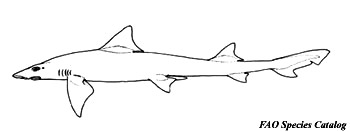
Mustelus norrisi
This slender shark has oval eyes over a pointed snout, long pectoral fins, and an asymmetrical caudal (tail) fin with a pointed lower lobe that trails back. It is a gray on top, fading to dirty white underneath, ideal for blending into the sandy or muddy bottoms of shallow bays along the western Atlantic. Because of their size, growing to a maximum of three and a half feet long, they are considered harmless to humans.
Order: Carcharhiniformes
Family: Triakidae
Genus: Mustelus
Species: norrisi
Common Names
Common names of Mustelus norrisi include narrowfin smooth-hound (English), Florida smooth-hound (English), Florida dogfish (English), floridatoonhaii (Dutch), cazón (Spanish), cazón perro (Spanish), emissole vueve (French), musola parda (Spanish), musola viuda (Spanish), viuda (Spanish) and viuda virma (Spanish).
Importance to Humans
Throughout its range there is a small commercial fishery for narrowfin smooth-hound. They are often taken in fishing nets close to shore.
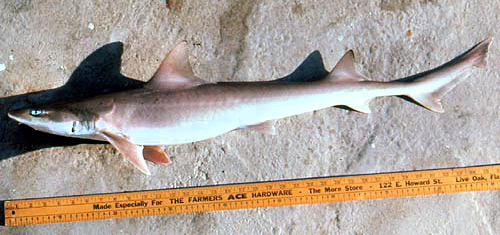
Danger to Humans
This small shark is considered harmless to humans. According to the International Shark Attack File, there have been no reported attacks on humans attributed to this species.
Conservation
The status of this species is uncertain due to incomplete data; however, it is known to have low resilience. Even without fishing pressure the species’ population size would require 14 years to double.
> Check the status of the narrowfin smooth-hound at the IUCN website.
The IUCN is a global union of states, governmental agencies, and non-governmental organizations in a partnership that assesses the conservation status of species.
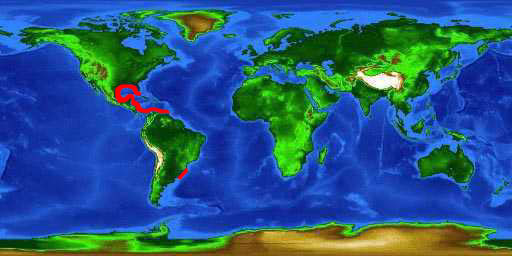
Geographical Distribution
The narrowfin smooth-hound is found in the western Atlantic Ocean from Florida and the Gulf of Mexico to Venezuela and southern Brazil. It is most common off the west coast of Florida.
Habitat
The narrowfin smooth-hound is found in waters over the continental shelves and is very common in muddy and sandy bottom shallow bays at depths of 10-14 feet (3-4 m). Individuals have been recorded at depths up to 264 feet (80m).
Distinguishing Characteristics
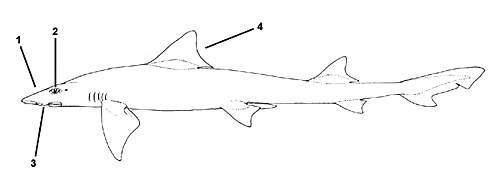
1. Head is short and narrow
2. Eye is large
3. Mouth is long
4. Fins are strongly falcate
Biology
Distinctive Features
The body of the narrowfin smooth-hound is slender with a prominent spiracle behind each eye. The dorsal fins are falcate with serrated trailing edges. The first dorsal fin begins well posterior to the pectoral axil. The second dorsal fin is significantly larger than the anal fin. The pectoral fins are small. The most distinctive feature of the narrowfin smooth-hound is the expansion of the lower anterior corner of the caudal fin as a sharp pointed lobe directed rearward.
The smooth dogfish (M. canis) is a similar species but has a much wider distance between the nostrils. The most distinguishing characteristic between M. canis and M. norrisi is the caudal fin. M. canis has a caudal fin with a rounded lower lobe, whereas M. norrisi has a sharp point on the lower lobe.
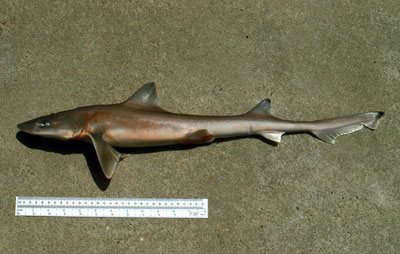
Coloration
The narrowfin smooth-hound is gray above with a paler dirty white underside. Adults lack spots or distinctive markings on the body or fins. The tips of the caudal and dorsal fins have a dusky color in newborn young.
Dentition
The teeth of the narrowfin smooth-hound are small with numerous pavement-like blunt cusps. Dentition is similar in the upper and lower jaws.
Denticles
Dermal denticles of this species are not distinguishable from M. canis. Denticles are irregularly spaced sometimes overlapping as well as leaving areas of skin visible. They have 2-6 longitudinal ridges and are sometimes weakly notched.
Size, Age, and Growth
The narrowfin smooth-hound grows to a maximum of 3.6 feet (110 cm) total length and a weight of 30.8 pounds (13.8 kg), with an average size of 30 inches (75 cm) for males and about 35 inches (90 cm) for females. Maturity occurs in males around 23 inches (58 cm) and females at 26 inches (65 cm) total length.
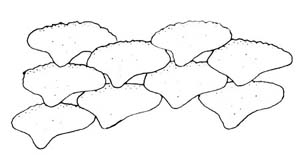
Food Habits
Prey items of the narrowfin smooth-hound include crabs, shrimp, and small bony fish.
Reproduction
The narrowfin smooth-hound is a viviparous species. The embryos are nourished via a yolk-sac and then a yolk-sac placenta while developing inside the mother’s body. The birth season is thought to occur in late winter to early spring, with live birth of 7 to 14 pups per litter. Birth size of each newborn pup is approximately 12 inches (30 cm) in length.
Predators
Potential predators of the narrowfin smooth-hound are larger sharks, including the dusky shark (Carcharhinus obscurus), blacktip shark (Carcharhinus limbatus) and great hammerhead (Sphyrna mokarran).
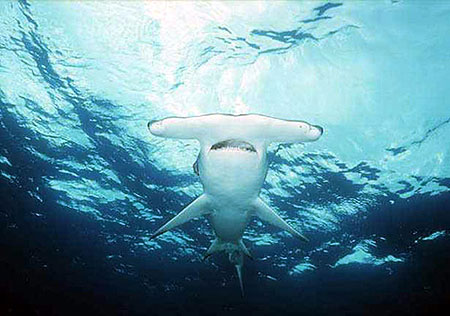
Parasites
The narrowfin smooth-hound is a known host to the parasitic copepod Perissopus dentatus, which can be found on the trailing edge of fins.
Taxonomy
The narrowfin smooth-hound was originally described by Springer in 1940. The genus name Mustelus is derived from the Latin “mustela” meaning weasel. There are no known synonyms used to refer to this species in past scientific literature.
Prepared by: Taylor Chapple